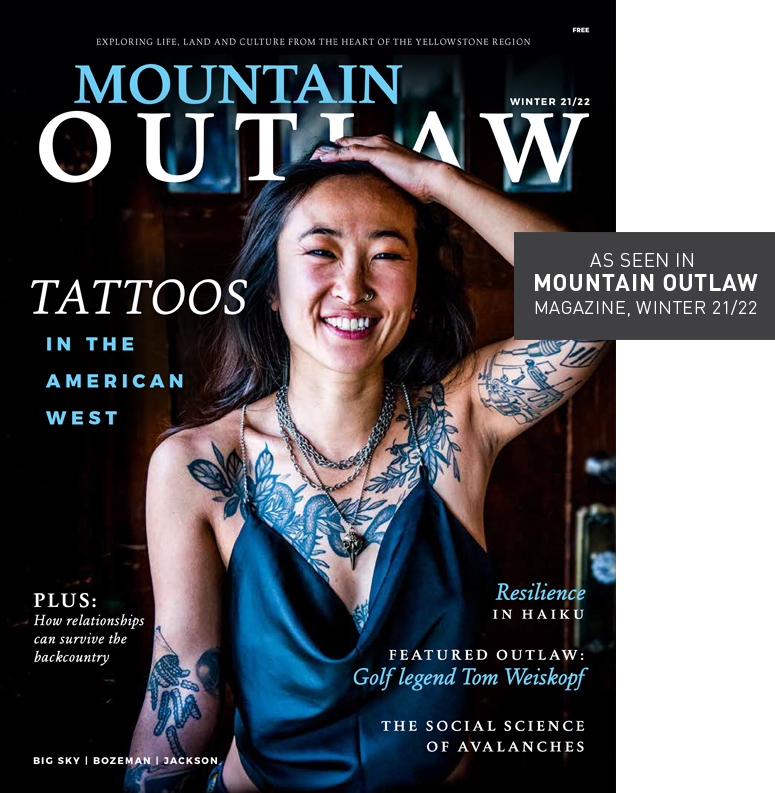Mary Jane debuts in the Treasure State.
BY BELLA BUTLER
In 2011, federal agents raided medical marijuana dispensaries across 13 Montana communities, handing down 26 indictments and placing nearly out of reach the prospect that recreational pot use would ever be legal in the Treasure State. Now, a decade later, Montana is joining 18 other U.S. states in legalizing adult-use marijuana.
Like smoke wafting from the end of a pipe, cannabis has drifted from Montana’s Wild West fringe to the forefront of its culture, lighting up a multi-million-dollar industry. Beginning on January 1, 2022, adults 21 and over will shop for marijuana products freely and legally. This journey from impossibility to inevitability is not unfamiliar to the state; Montana was the first to repeal enforcement of Prohibition nearly a century ago.
“We’ve had alcohol in Montana since 1926,” said Kristan Barbour, administrator of the state’s Cannabis Control Division. “Somehow, no one has any problems with sitting in a bar and having a glass of wine or … traveling the state to go to different breweries or distilleries. We’ve gotten over that hurdle. I do believe cannabis has that same opportunity.”
In November 2020, Montanans passed a pair of initiatives—I-190 and CI-118—that together legalized adult-use recreational marijuana. The initiatives were top performers in the election, each raking in nearly 60 percent of favorable votes, as many as Donald Trump in 2020.
Pepper Petersen, a leader for the 2020 pro-cannabis campaign New Approach, had a heavy hand in the passing of the initiatives. Petersen doesn’t fit within the commonly held stoner archetype; no tie- dyed shirt, no skateboard clutched under an arm. Sunken into the leather couch in his Helena-based dispensary, he sports a black cowboy hat, black leather boots and an intricately beaded belt buckle gifted him by a friend from the Crow Reservation.
But Montana’s marijuana culture itself doesn’t fit into a stereotype, he argues, which is partly why it was so successful. “You notice our campaign didn’t employ Snoop Doggy Dog,” he said. “It was Willie Nelson.”
After the 2020 election, Montana’s 67th Legislature sent the long-debated 153-page House Bill 701 to Montana Gov. Greg Gianforte’s desk, where he signed it into law on May 20, 2021.
Adult-use marijuana is projected to rake in nearly $1.2 billion in sales through the end of 2026.
This legislation is exhaustive. When he introduced the bill in its first hearing during the legislative session, Republican Representative Mike Hopkins, the bill’s primary sponsor stated: “House Bill 701 is a comprehensive, fully functional, operational system for the safe, controlled, responsible implementation of the growing, the tracking, the testing, the transporting, the manufacturing, the selling, and the taxing of adult-use marijuana in the state of Montana.” While the bill may not be the most comprehensive in the nation, he said, it’s certainly one of them.
Something Petersen and Barbour are now especially excited for is the shift from a vertically integrated market to a horizontal one. Before 2022, dispensaries also had to be growers and producers. Now, they’ll have the option to specialize and do business with other growers, producers and shops throughout the state, something Petersen says will boost innovation.
While adult-use marijuana is legal to possess statewide, an “11th-hour addition” to HB 701, according to Barbour, established green and red counties, currently splitting the state nearly in half. In green counties, where the majority of voters approved I-190 in 2020, the sale of adult-use marijuana will be available on January 1, 2022. In red counties, where voters rejected I-190, it won’t be. Either type of county can change its designation by putting it to a vote.
Just as the law is far-reaching, so will be the industry. During its campaign, New Approach commissioned an economic report from the University of Montana that estimated total cannabis users in the state would exceed 873,000 by 2026, a more than 2,100 percent increase from Montana’s nearly 39,000 medical cardholders.
The report projected adult-use marijuana would rake in nearly $1.2 billion in sales through the end of 2026.
Adult-use marijuana also comes with a 20 percent sales tax, which HB 701 divvies into several pools including an addiction and recovery fund, several conservation and recreation sources, veterans’ services, the Department of Justice, and the state general fund. Counties also have the chance to add a 3 percent local-option tax. The UM report estimates the tax will generate more than $236 million in tax revenue through 2026.
Barbour described the first year of Montana’s adult-use marijuana program as both a full launch and a pilot. Just like the medical marijuana program, she suspects regulation will change with each legislative session, and the industry will have to iron out some kinks. But for now, across the threshold of legalization, a new cultural truth has ignited across Montana; a perceived impossibility is now an inevitability.
Bella Butler is Senior Editor for Mountain Outlaw magazine and its sister publication, Explore Big Sky newspaper.

